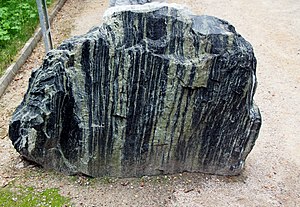Amphibolite
Metamorphic rock | |
 An amphibolite boulder in the Botanical Gardens of Charles University, Prague, Czech Republic. | |
| Composition | |
|---|---|
| Amphiboles, such as hornblende and actinolite, often with plagioclase. | |
| Physical Characteristics | |
| Fabric | Schistose |
| Relationships | |
| Protoliths | Mafics, such as basalt |


Amphibolite (
Amphibolite frequently forms by
Although tremolite is a metamorphic amphibole, it is most commonly derived from highly metamorphosed
Ortho-amphibolite vs. para-amphibolite
Metamorphic rocks composed primarily of amphibole, plagioclase, with subordinate epidote, zoisite, chlorite, quartz, titanite, and accessory leucoxene, ilmenite and magnetite which have a protolith of an igneous rock are known as ortho-amphibolite.
Para-amphibolite will generally have the same equilibrium mineral assemblage as ortho-amphibolite, with more biotite, and may include more quartz, plagioclase, and depending on the protolith, more calcite/aragonite and wollastonite.
Often the easiest way to determine the true nature of an amphibolite is to inspect its field relationships; especially whether it is interfingered with other metasedimentary rocks, especially greywacke and other poorly sorted sedimentary rocks. If the amphibolite appears to transgress apparent protolith bedding surfaces it is an ortho-amphibolite, as this suggests it was a dyke. Picking a sill and thin metamorphosed lava flows may be more troublesome.
Thereafter, whole rock geochemistry will suitably identify ortho- from para-amphibolite.
The word metabasalt was thus coined, largely to avoid the confusion between ortho-amphibolite and para-amphibolite. This term is recommended by the British Geological Survey when it is possible to determine the origin of the rock from its characteristics alone (and not from field relationships), particularly when the degree of metamorphism is low.[1]
Amphibolite facies


Amphibolite as a rock defines a particular set of temperature and pressure conditions known as the amphibolite facies. However, caution must be applied here before embarking on metamorphic mapping based on amphibolite alone.
First, for an ortho-amphibolite or amphibolite to be classed as a metamorphic amphibolite, it must be certain that the amphibole in the rock is a prograde metamorphic product, and not a retrograde metamorphic product. For instance, actinolite amphibole is a common product of retrograde metamorphism of metabasalt at (upper) greenschist facies conditions. Often, this will take on the crystal form and habit of the original protolith assemblage; actinolite pseudomorphically replacing pyroxene is an indication that the amphibolite may not represent a peak metamorphic grade in the amphibolite facies. Actinolite schist is often the result of
Second, the microstructure and crystal size of the rock must be appropriate. Amphibolite facies conditions are experienced at temperatures in excess of 500 °C and pressures less than 1.2 GPa, well within the ductile deformation field. Gneissic texture may occur nearby, if not then mylonite zones, foliations and ductile behaviour, including stretching lineations may occur.
While it is not impossible to have remnant protolith mineralogy, this is rare. More common is to find phenocrysts of pyroxene, olivine, plagioclase and even magmatic amphibole such as pargasite rhombohedra, pseudomorphed by hornblende amphibole. Original magmatic textures, especially crude magmatic layering in layered intrusions, is often preserved.
Amphibolite facies equilibrium mineral assemblages of various protolith rock types consist of:
- Basalt ortho-amphibolite; hornblende/actinolite +/- albite +/- biotite +/- quartz +/- accessories; often remnant greenschist facies assemblages including, notably, chlorite
- High-magnesia basalt; as ortho-amphibolite, but may contain anthophyllite, a Mg-rich amphibole
- Ultramafic rocks; tremolite, asbestiform amphibole, talc, pyroxene, wollastonite, prograde metamorphic olivine (rarely)
- Sedimentary para-amphibolite; hornblende/actinolite +/- albite +/- biotite +/- quartz +/- garnet (calcite +/- wollastonite)
- Pelite; quartz, orthoclase +/- albite, +/- biotite +/- actinolite +/- garnet +/- staurolite +/- sillimanite
Amphibolite facies is usually a product of Barrovian Facies Sequence or advanced Abukuma Facies Sequence metamorphic trajectories. Amphibolite facies is a result of continuing burial and thermal heating after
Uralite
Uralite is a particular
Epidiorite
The archaic term epidiorite is sometimes used, especially in Europe, to refer to a metamorphosed ortho-amphibolite with a
uralite.Uses
Amphibolite was a favourite material for the production of
Amphibolite is a common dimension stone used in construction, paving, facing of buildings, especially because of its attractive textures, dark color, hardness and polishability and its ready availability.[citation needed]
References
- ^ Robertson, S. (1999). "BGS Rock Classification Scheme, Volume 2: Classification of metamorphic rocks" (PDF). British Geological Survey Research Report. RR 99-02. Retrieved 27 February 2021.
- Winter, John D., 2001. An introduction to Igneous and Metamorphic Petrology, 695 pages, Prentice Hall, ISBN 0-13-240342-0
This article needs additional citations for verification. (November 2011) |
